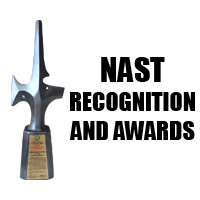S&T Human Resource Development: Looking Back and Looking Forward
- Details
In order to propose a 6-year science and technology (S&T) human resource development strategy, the National Academy of Science and Technology, Philippines (NAST PHL) have gathered stakeholders from the Department of Science and Technology (DOST), the academe, concerned public and private institutions, participants from the professional societies, industry sector, and the media for a policy forum on June 30, 2016 at Astoria Plaza Manila.
The Policy Forum on S&T Human Resource Development: Looking Back and Looking Forward aims to look at the current state of S&T personnel in the Philippines, challenges, and opportunities faced in a growing knowledge economy, the need for more research scientists and engineers for the country and propose resolutions to address current issues and concerns regarding S&T competencies, talent mobility, and job opportunities.
The participants were welcomed by Academician (Acd.) Fabian M. Dayrit, acting president of NAST PHL. He also presented about the National Science Consortium: its members, initiatives, and activities. “It takes an ecosystem to train a scientist,” he stressed as he narrates the challenges, opportunities, and areas for improvement in government support relative to the development of S&T human resource in the country.
Forum on the Challenges and Opportunities in the Implementation of the K-12 Science, Technology, Engineering, and Mathematics (Stem) Curriculum
- Details
On June 23, 2016, the National Academy of Science and Technology, Philippines, through the Mathematical and Physical Sciences Division (MPSD), conducted the Forum on the Challenges and Opportunities in the Implementation of the K-12 Science, Technology, Engineering, and Mathematics (STEM) Curriculum. Various stakeholders of the program, from the academe and public and private institutions, participated in the forum.
Academician William G. Padolina, member of MPSD, welcomed the participants and pointed out that "having the K-12 system in place does not exactly mean that there is no more room for improvement.” He acknowledges that “there is still work that needs to be done in addressing the challenges in implementation and in improving the system and the curriculum itself as we are already in the last phase of the transition period.”
Mr. Joseph R. Jacob, supervising education program specialist of the Bureau of Curriculum Development - Curriculum Standards Development Division, Department of Education (DepEd), discussed the current status of the K-12 STEM program. The reform in the curriculum intends to produce scientifically, environmentally, and technologically literate graduates with 21st century skills. Mr. Jacob explained that in ensuring the efficiency of the program, DepEd has conducted consultative meetings with concerned stakeholders in developing the science program curriculum and curriculum guides.
Research Ship Named in Honor of National Scientist Gregorio Velasquez
- Details
Last April, R/V Melville was renamed as BRP Gregorio Velasquez after National Scientist (NS) Gregorio T. Velasquez, who is recognized for his pioneer scientific studies of the biology, ecology and uses of Philippine algae.
NS Velasquez was selected as one of the first academicians of the National Academy of Science and Technology, Philippines (NAST PHL) in 1978 and was conferred the rank and title of National Scientist in 1983. He founded the Algological Society of the Philippines, which is now called the Phycological Society of the Philippines, in 1956.
Built in 1969, the 279-foot vessel was operated by Scripps Oceanographyas part of the University-National Laboratory System (UNOLS) to conduct general oceanographic research functions.It is equipped with permanent scientific equipment such as multibeam, sub-bottom profiler, magnetometer, gravity meter, an acoustic Doppler current profiler and an underway data system, which can support a wide range of activities across every discipline of oceanography.
BRP Gregorio Velasquez was turned over to the Philippine Navy by the US government as promised by US President Barack Obama during his APEC visit in the country last year. It is expected to render services for oceanographic and environmental research. The naval ship will be used to study the Benham Rise, a minerals- and natural gas- rich region located in the Philippine Sea, about 250 km east of the northern coastline of Isabela in northern Luzon. ~Ana Loren B. Durana











